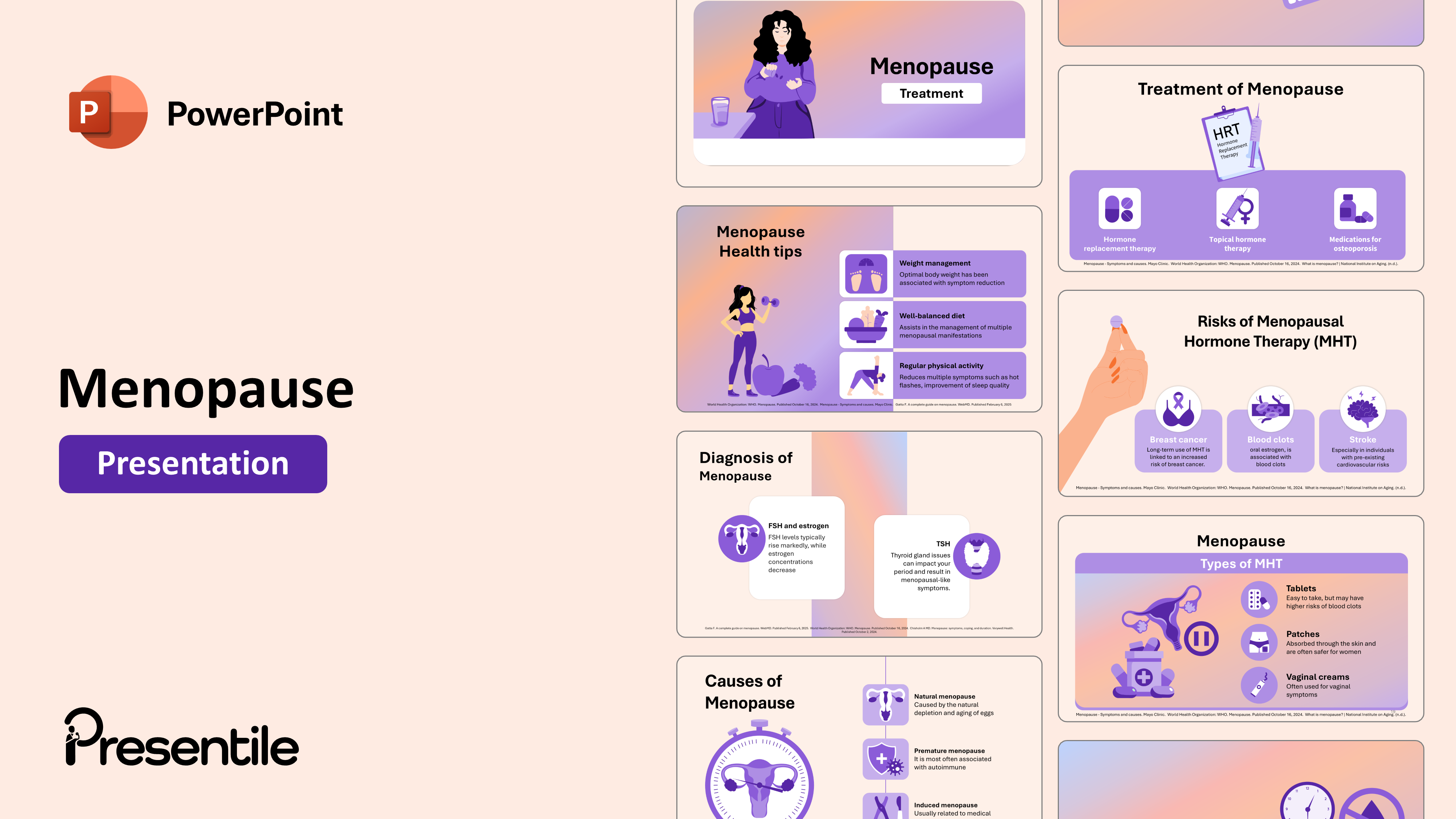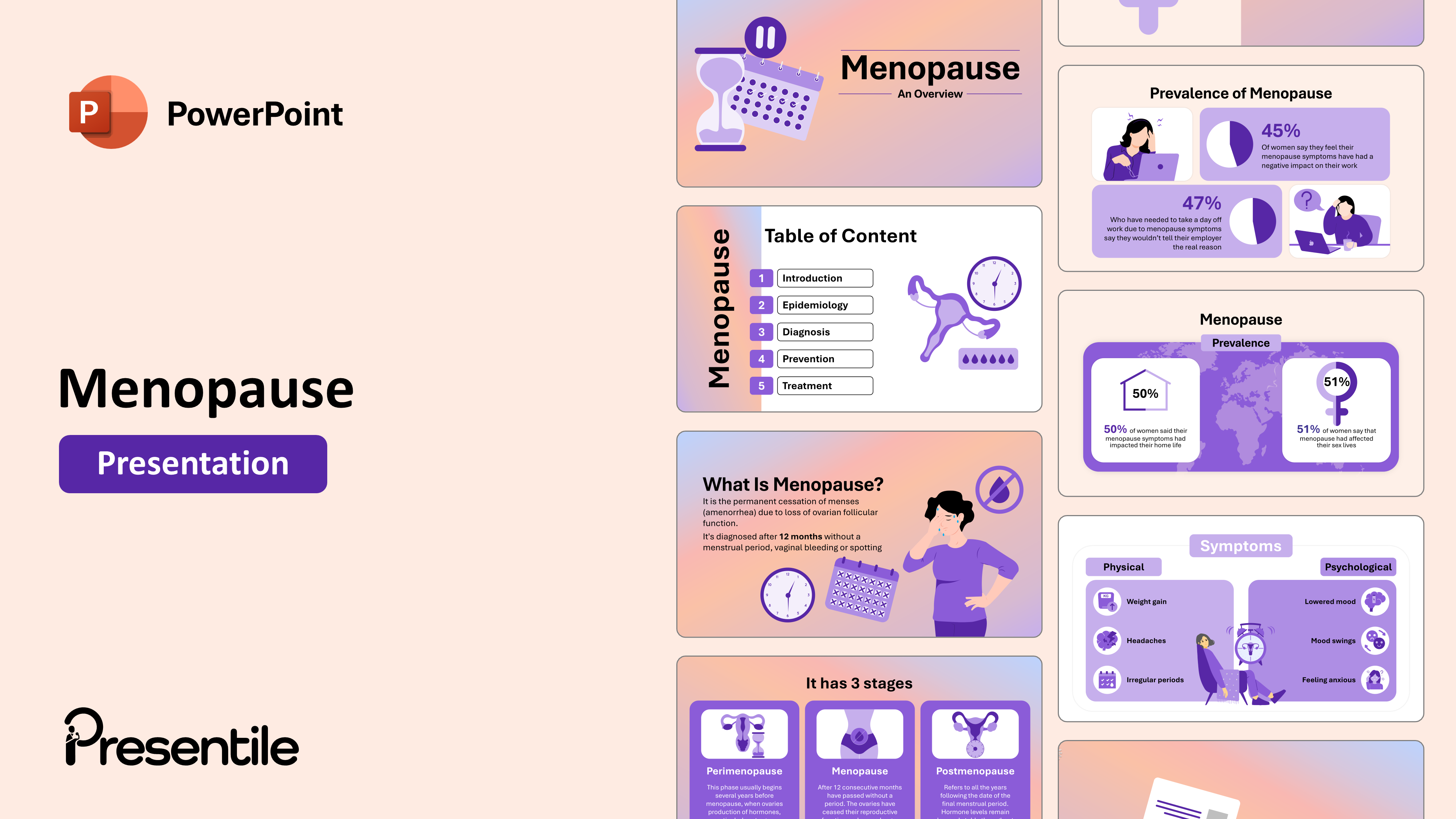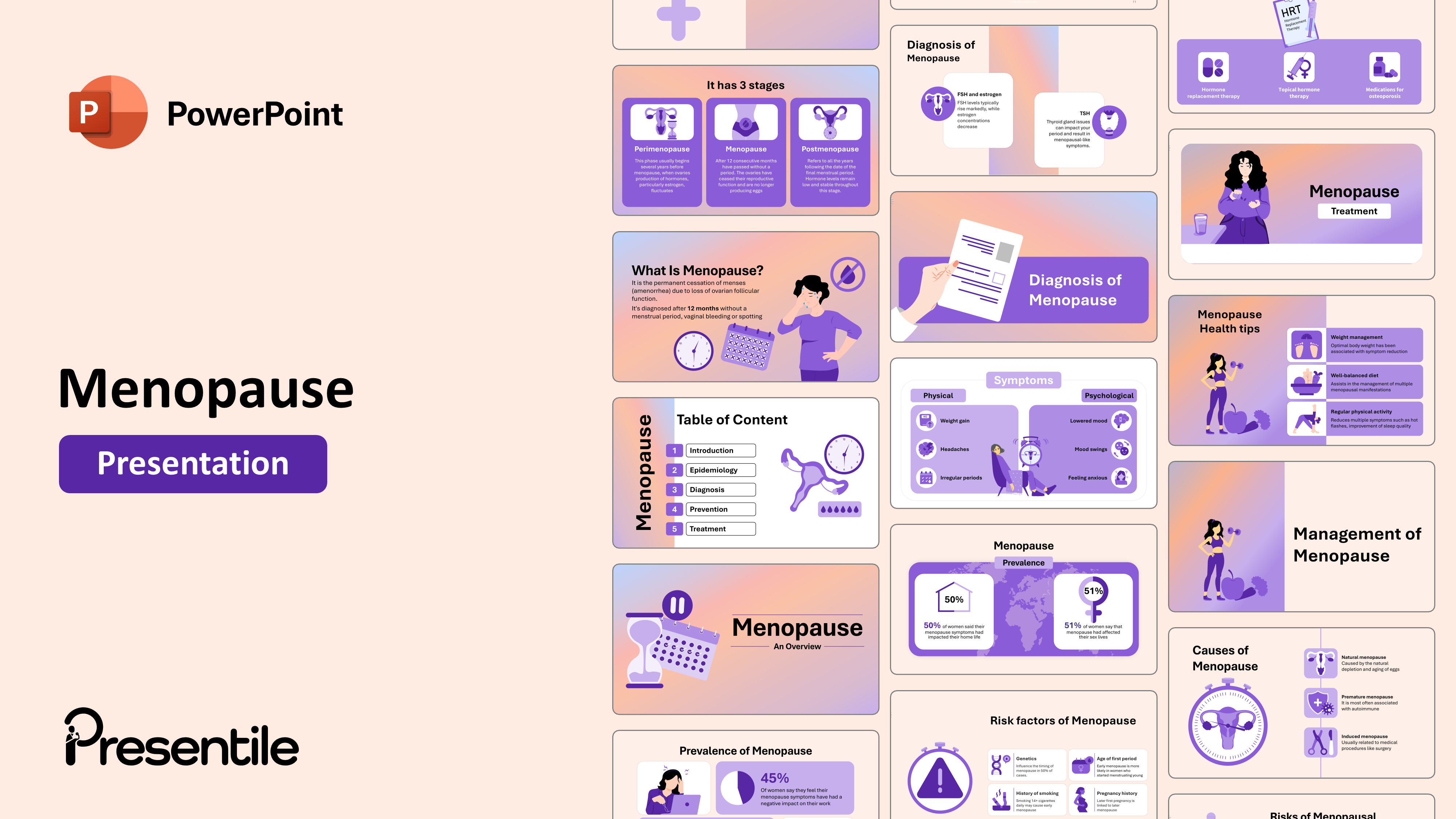
Content of
Menopause Presentation
Slide 1: Menopause – An Overview
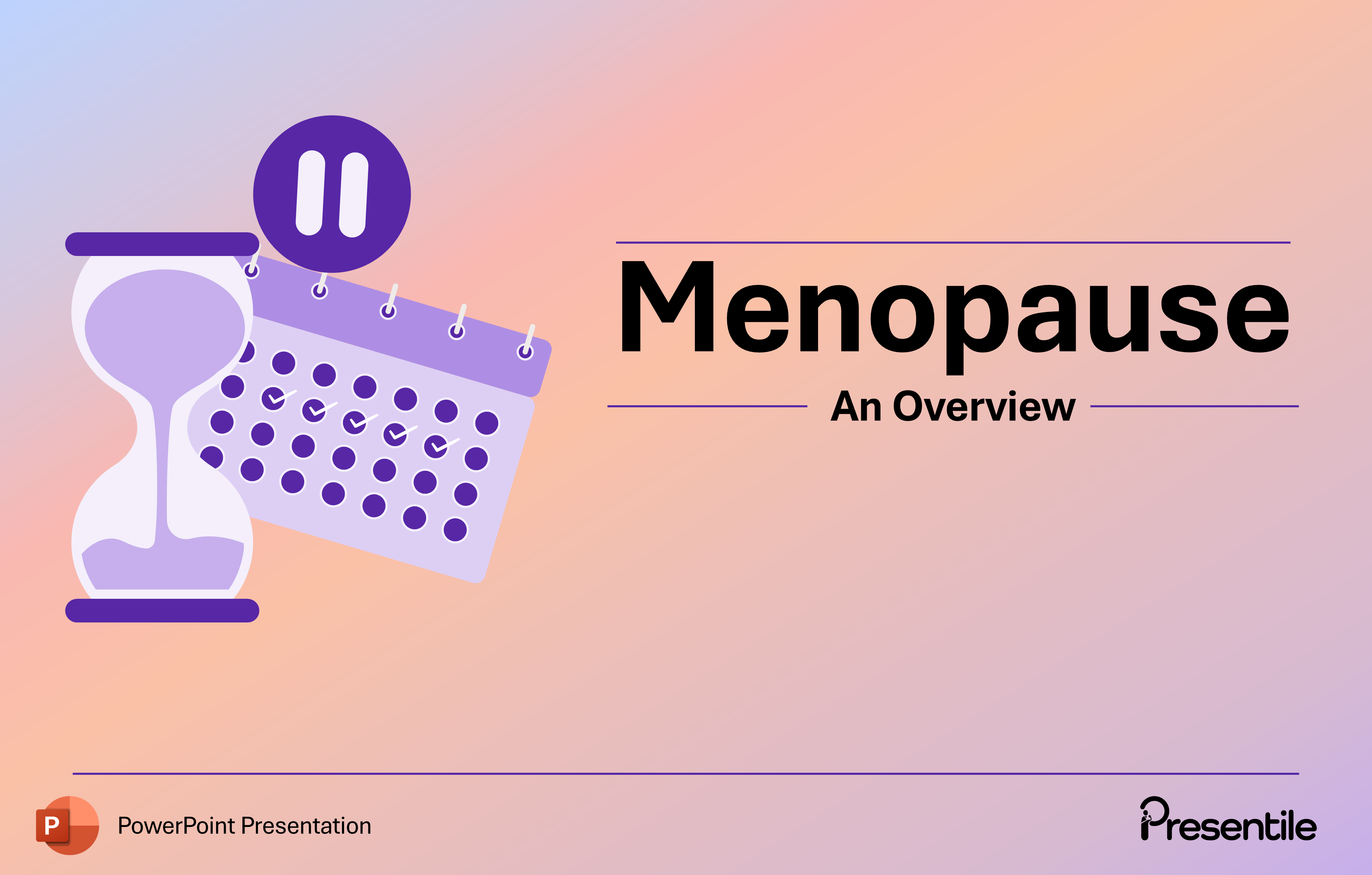
This is the title slide for a presentation offering an overview of Menopause.
The design uses a soft, gradient background and strong, clear visuals related to the subject:
- Hourglass: Symbolizes the passage of time and the biological transition inherent to menopause.
- Calendar with a "Pause" symbol: Directly represents the cessation of the menstrual cycle, which is the clinical definition of menopause.
- The bold "Menopause" with the subtitle "An Overview" clearly and concisely introduces the topic.
Slide 2: Table of Content – Menopause Overview
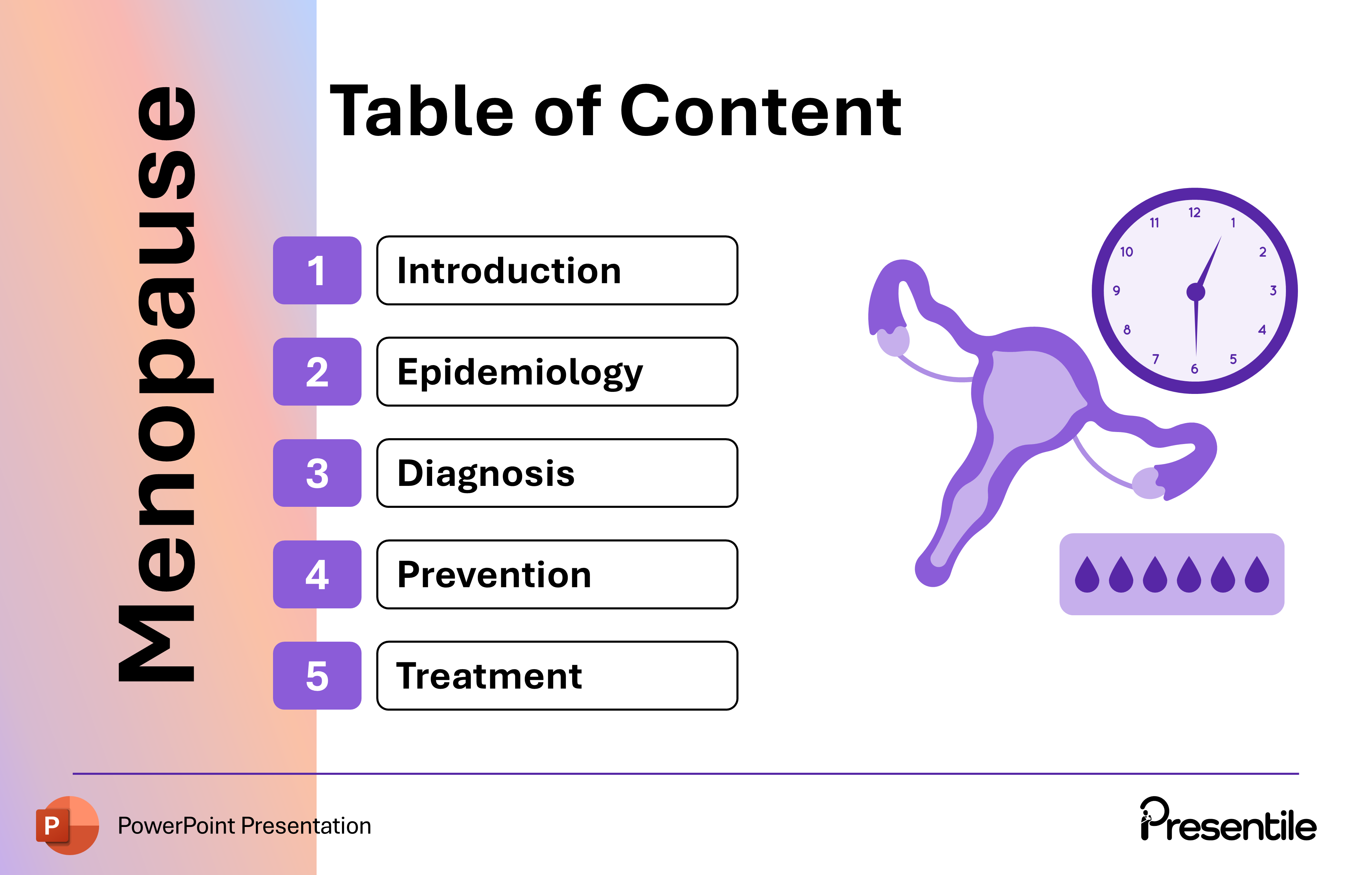
This slide serves as the agenda, outlining the five main topics to be covered in the presentation. The design uses a purple color scheme and relevant visuals to reinforce the subject matter.
- Visuals: A clock and a simplified illustration of the female reproductive system (uterus, fallopian tubes, ovaries) emphasize the biological and temporal aspects of menopause. Menstrual blood drops below symbolize the cessation of the cycle.
- Content Sections: The presentation is clearly organized into the following sections:
- Introduction
- Epidemiology
- Diagnosis
- Prevention (likely referring to preventative health measures during and after menopause)
- Treatment
Slide 3: Defining Menopause
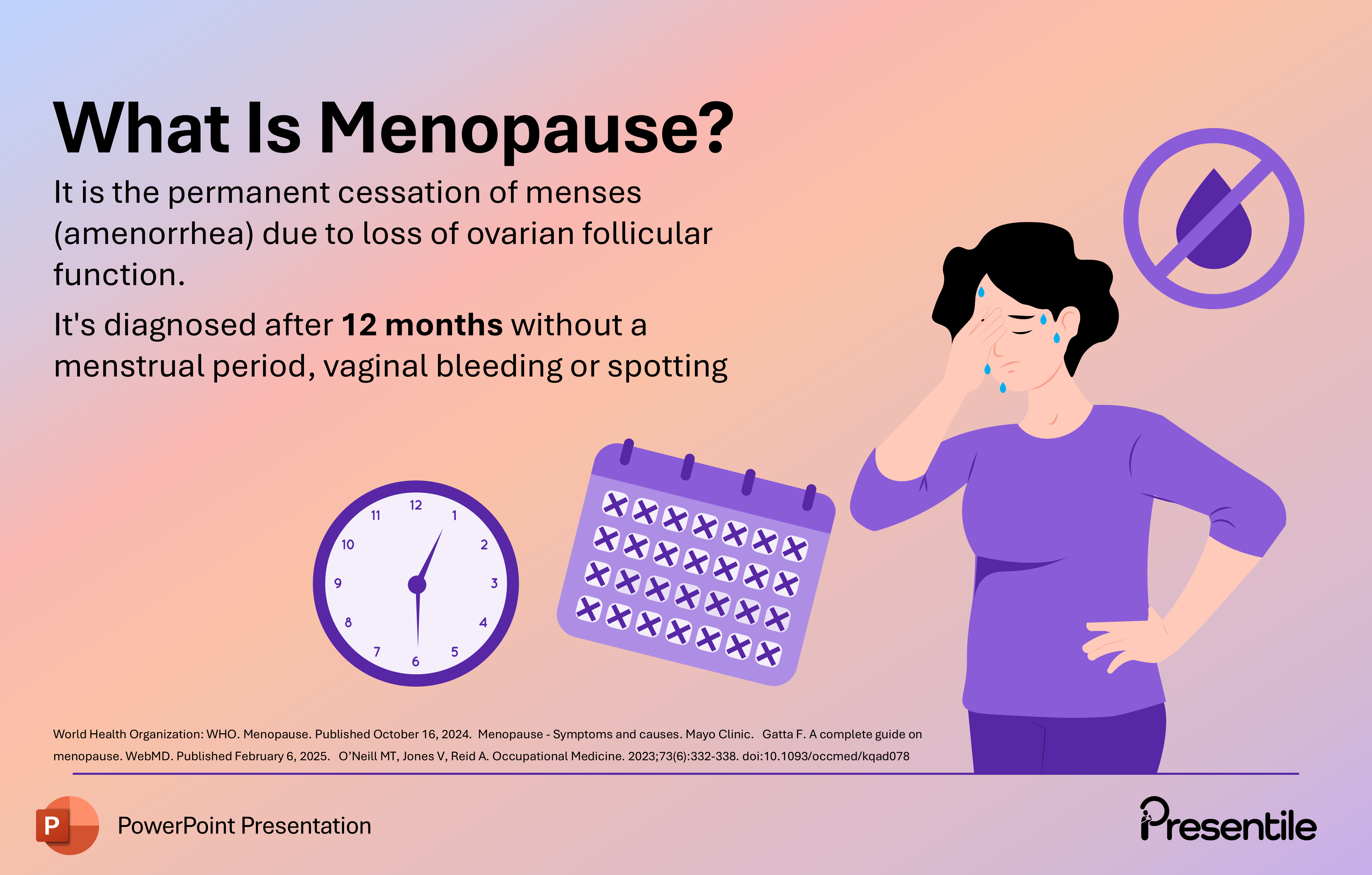
This slide provides the clinical definition of menopause, detailing its biological cause and the diagnostic criteria. The design features a distressed woman, a calendar, and a clock, visually conveying the emotional and chronological aspects of the condition.
- Core Definition: Menopause is defined as "The permanent cessation of menses (amenorrhea) due to loss of ovarian follicular function." This explains the root cause as the biological exhaustion of egg-producing follicles.
- Diagnosis Criteria: Clinically, "It's diagnosed after 12 months without a menstrual period, vaginal bleeding or spotting." This establishes the precise time frame required for a medical diagnosis.
Slide 4: The 3 Stages of Menopause

This slide clearly delineates the three clinical stages of the menopausal transition. The use of three distinct, color-coded columns makes the distinction between the stages easy to follow. Each stage is paired with a relevant visual of the female reproductive system to represent the hormonal state.
- Perimenopause:
- Description: "This phase usually begins several years before menopause, when ovaries production of hormones, particularly estrogen, fluctuates."
- Visual: Uterus with an hourglass, signifying the beginning of the transition.
- Menopause:
- Description: "After 12 consecutive months have passed without a period. The ovaries have ceased their reproductive function and are no longer producing eggs."
- Visual: Uterus with a "pause" symbol on the abdomen, confirming the cessation.
- Postmenopause:
- Description: "Refers to all the years following the date of the final menstrual period. Hormone levels remain low and stable throughout this stage."
- Visual: Uterus with a clock, symbolizing the long-term, stable phase following the transition.
Slide 5: Section Focus: Prevalence of Menopause
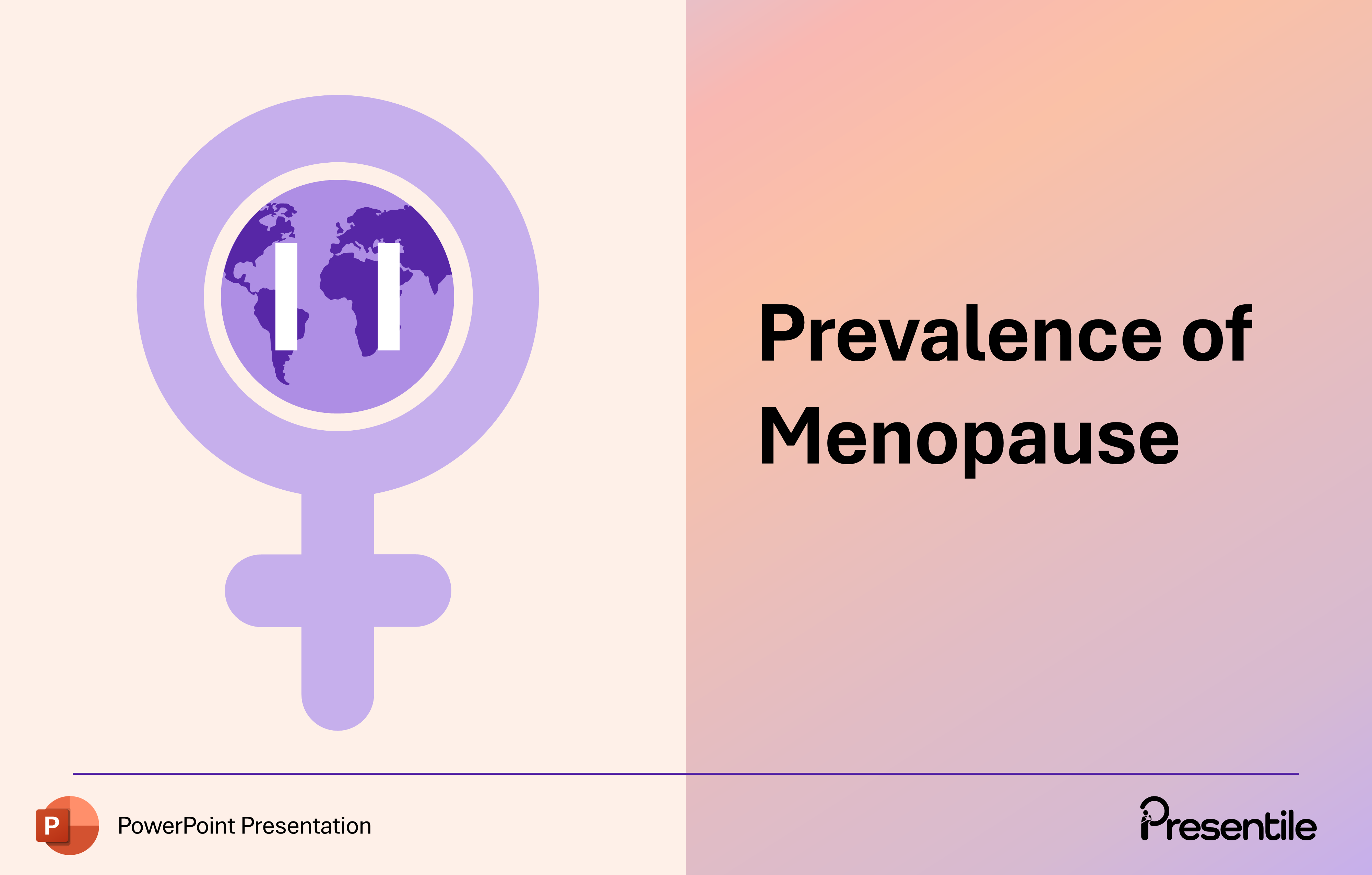
This slide serves as a transitional header, shifting the presentation's focus to the statistical data and distribution of Menopause.
The slide prominently features the title "Prevalence of Menopause." On the left, a female gender symbol contains a globe and a "pause" symbol, which visually ties together the global nature of this condition and its meaning (cessation). This prepares the audience for a discussion of the typical age of onset and worldwide data.
Slide 6: Prevalence of Menopause – Impact on Work
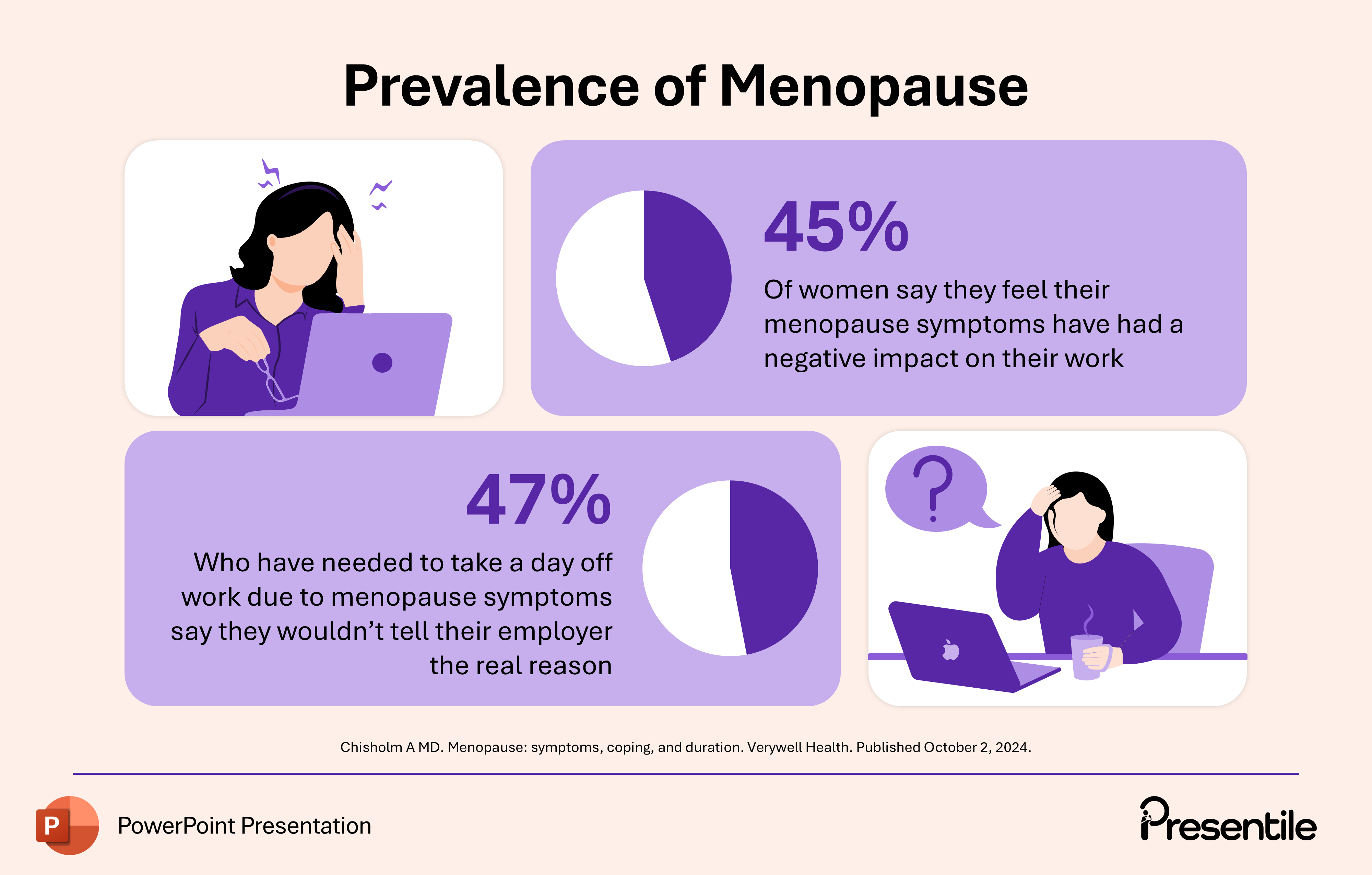
This slide provides key statistics on the impact of menopause symptoms, specifically within a work context. The statistics highlight the significant professional and social challenges faced by women during this transition.
- Negative Work Impact (45%): "Of women say they feel their menopause symptoms have had a negative impact on their work." This emphasizes the cognitive and physical challenges affecting job performance.
- Secrecy and Time Off (47%): "Who have needed to take a day off work due to menopause symptoms say they wouldn’t tell their employer the real reason." This statistic points to the lack of awareness and potential stigma surrounding menopause in the workplace.
Slide 7: Prevalence of Menopause – Home Life and Sexual Health

This slide continues the discussion on the sociological and personal impact of menopause, focusing on home life and sexual health. The statistics use strong visual icons (a house and a female symbol) to represent the areas of impact.
- Impact on Home Life (50%): "50% of women said their menopause symptoms had impacted their home life." This indicates that symptoms interfere with daily life, family, and domestic activities.
- Impact on Sex Life (51%): "51% of women say that menopause had affected their sex lives." This highlights the common physical and hormonal changes, such as vaginal dryness and loss of libido, which are significant quality-of-life issues.
Slide 8: Symptoms of Menopause – Physical and Psychological
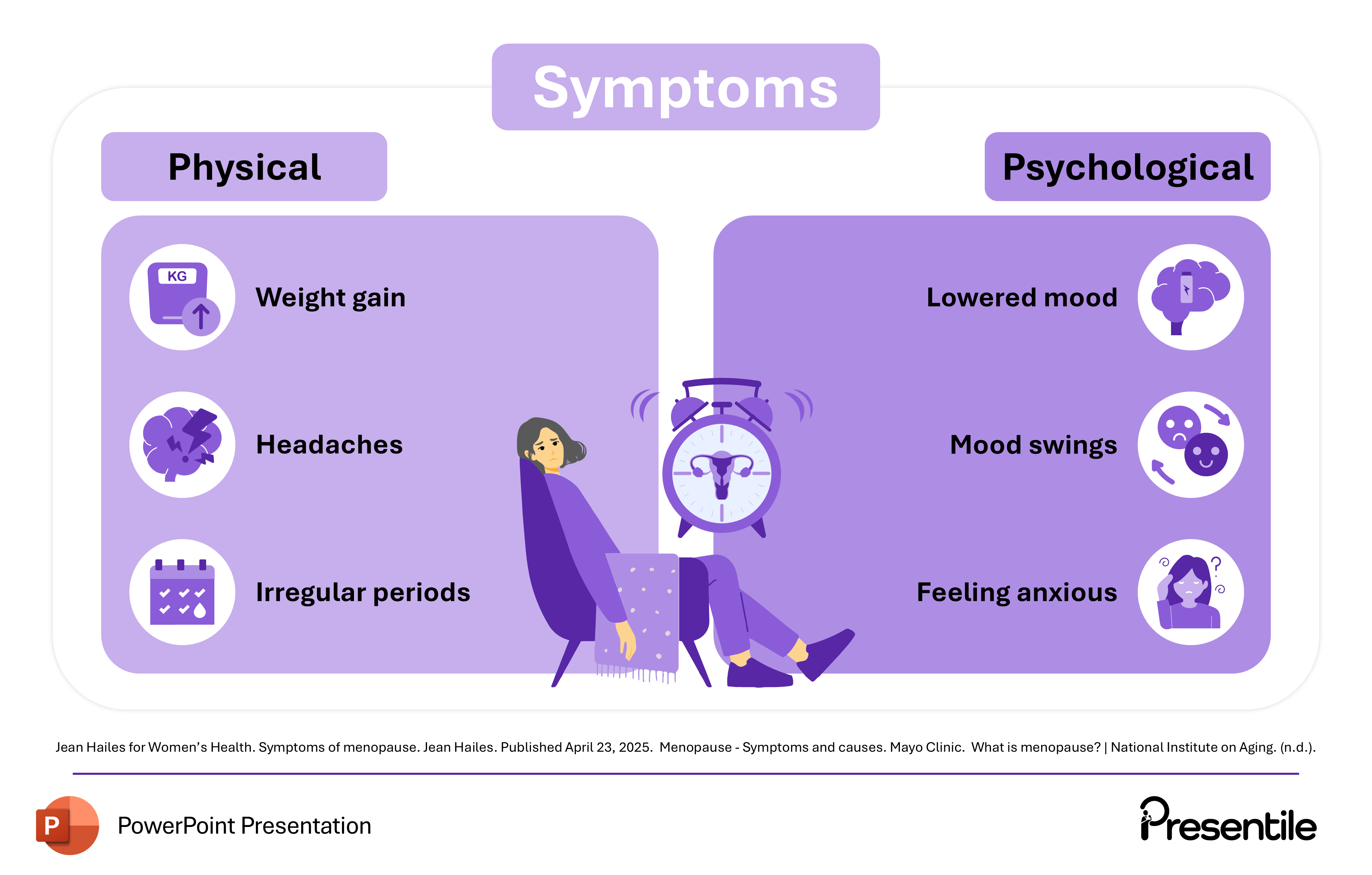
This slide provides a clear, categorized overview of the key symptoms experienced during menopause, dividing them into Physical and Psychological categories. A central illustration of a woman experiencing discomfort reinforces the subject.
- Physical Symptoms:
- Weight gain
- Headaches
- Irregular periods (especially relevant in perimenopause)
- Psychological Symptoms:
- Lowered mood
- Mood swings
- Feeling anxious
Slide 9: Section Focus: Diagnosis of Menopause
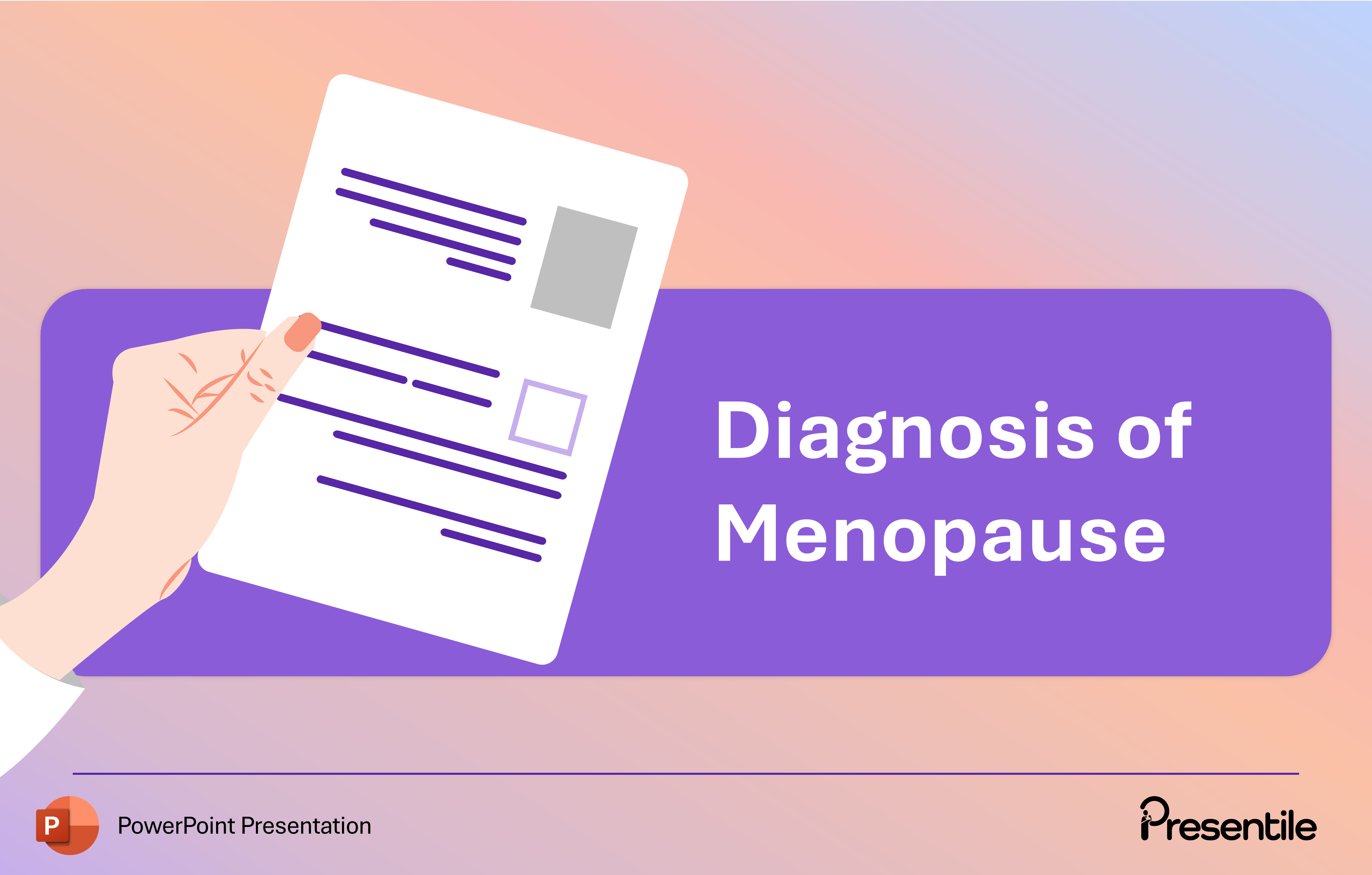
This slide serves as a clear transitional header for the Diagnosis section of the Menopause presentation. The title "Diagnosis of Menopause" is prominently displayed. The visual, a hand holding a stylized medical record or lab test form, immediately signals that the content is shifting to the methods and documentation used to confirm the clinical condition.
Slide 10: Diagnosis of Menopause – Hormone Levels and Differential Diagnosis

This slide details the laboratory tests used in the diagnosis of menopause, focusing on hormone levels and conditions that mimic menopausal symptoms. It is structured around the comparison of two key areas: Ovarian Function and Thyroid Function.
- FSH and Estrogen:
- Key Finding: "FSH levels typically rise markedly, while estrogen concentrations decrease." This is the hallmark hormonal change of menopause, reflecting the loss of ovarian follicular function. The visual is the uterus (ovarian function).
- TSH (Thyroid-Stimulating Hormone):
- Differential Diagnosis: "Thyroid gland issues can impact your period and result in menopausal-like symptoms." TSH testing is crucial to rule out thyroid dysfunction (hypothyroidism), which can cause similar symptoms to menopause. The visual is the thyroid gland.
Slide 11: Section Focus: Risk factors of Menopause
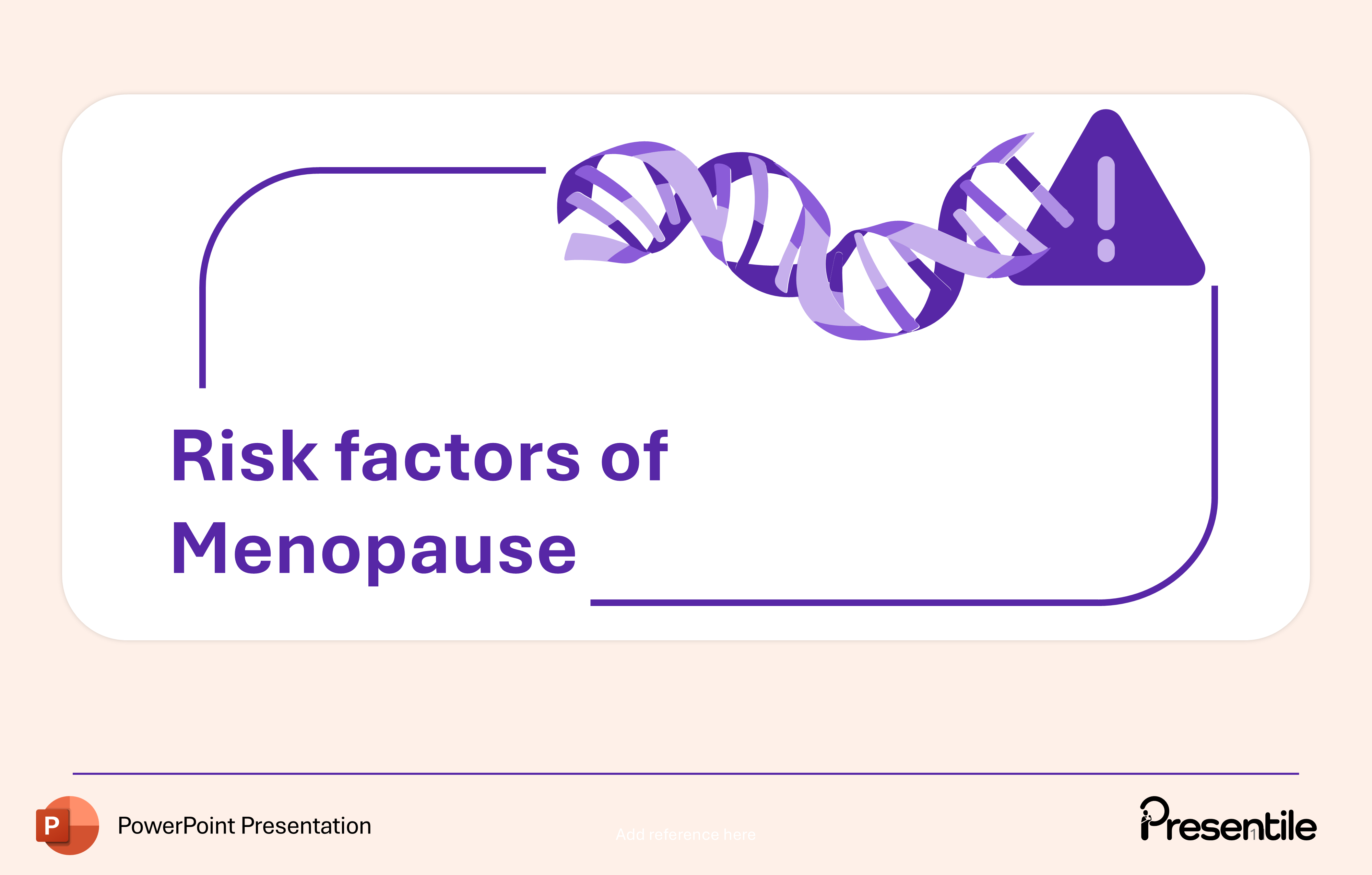
This slide serves as a transitional header, shifting the presentation's focus, perhaps from diagnosis to the long-term risks or predisposing factors for early menopause.
The title is "Risk factors of Menopause." The visual, a stylized DNA helix leading into a warning symbol, suggests a focus on the genetic or biological risks associated with the condition or its complications. Given your table of contents, this section is named "Prevention", so this slide will likely lead into content about mitigating the long-term risks of menopause (like osteoporosis or heart disease).
Slide 12: Risk Factors Influencing Menopause Timing
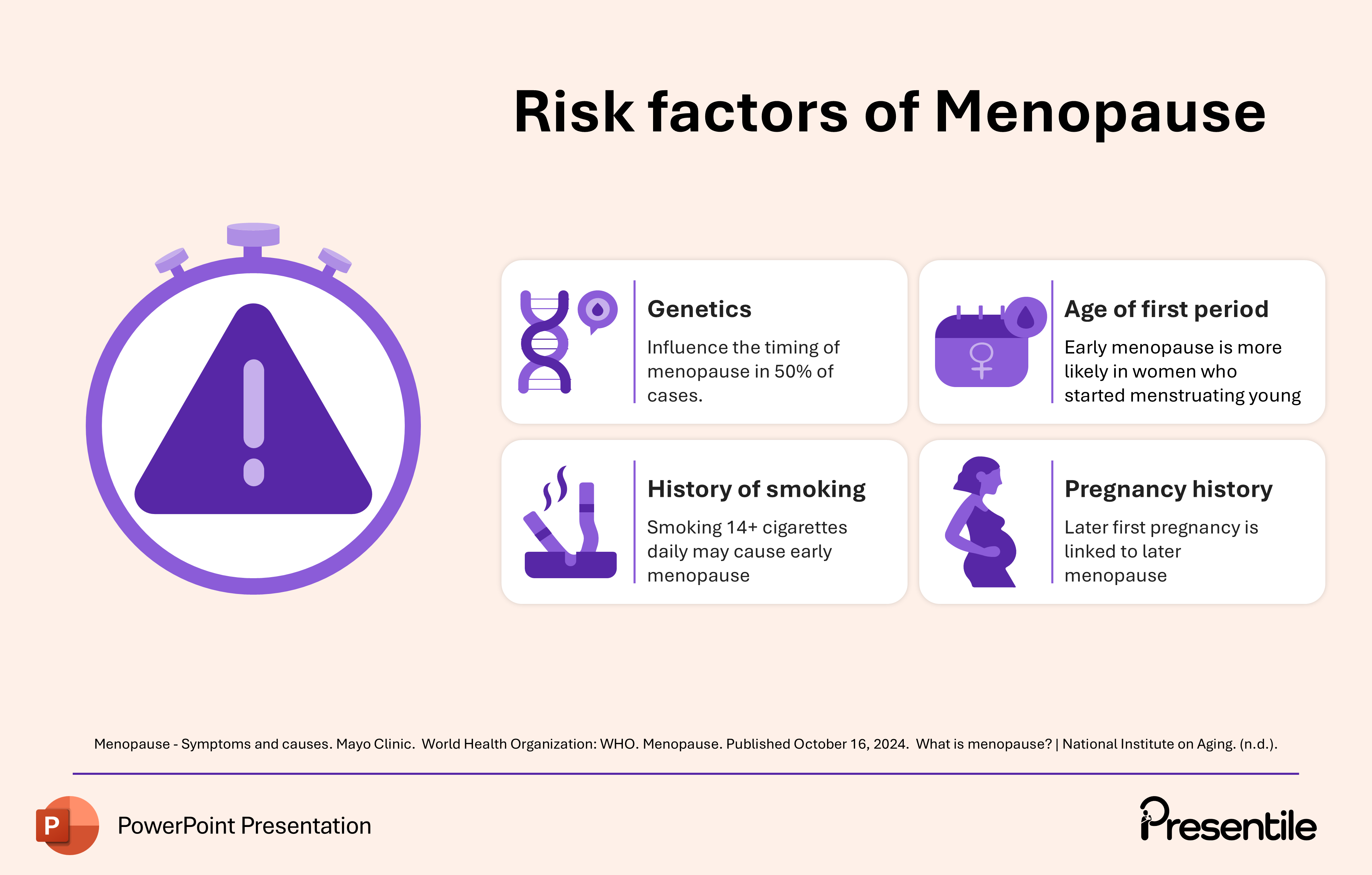
This slide details four key factors—genetic, lifestyle, and history—that influence the timing of menopause, particularly the risk of early onset. The central illustration of a stopwatch and a warning sign emphasizes the unpredictable element of timing.
- Genetics: "Influence the timing of menopause in 50% of cases." This highlights the strong hereditary component.
- Age of first period: "Early menopause is more likely in women who started menstruating young." This links the onset of reproductive life to the duration.
- History of smoking: "Smoking 14+ cigarettes daily may cause early menopause." This pinpoints a significant, modifiable lifestyle factor that shortens reproductive life.
- Pregnancy history: "Later first pregnancy is linked to later menopause." This suggests a possible hormonal or physiological link between reproductive events and the timing of cessation.
Slide 13: Causes of Menopause – Categorized
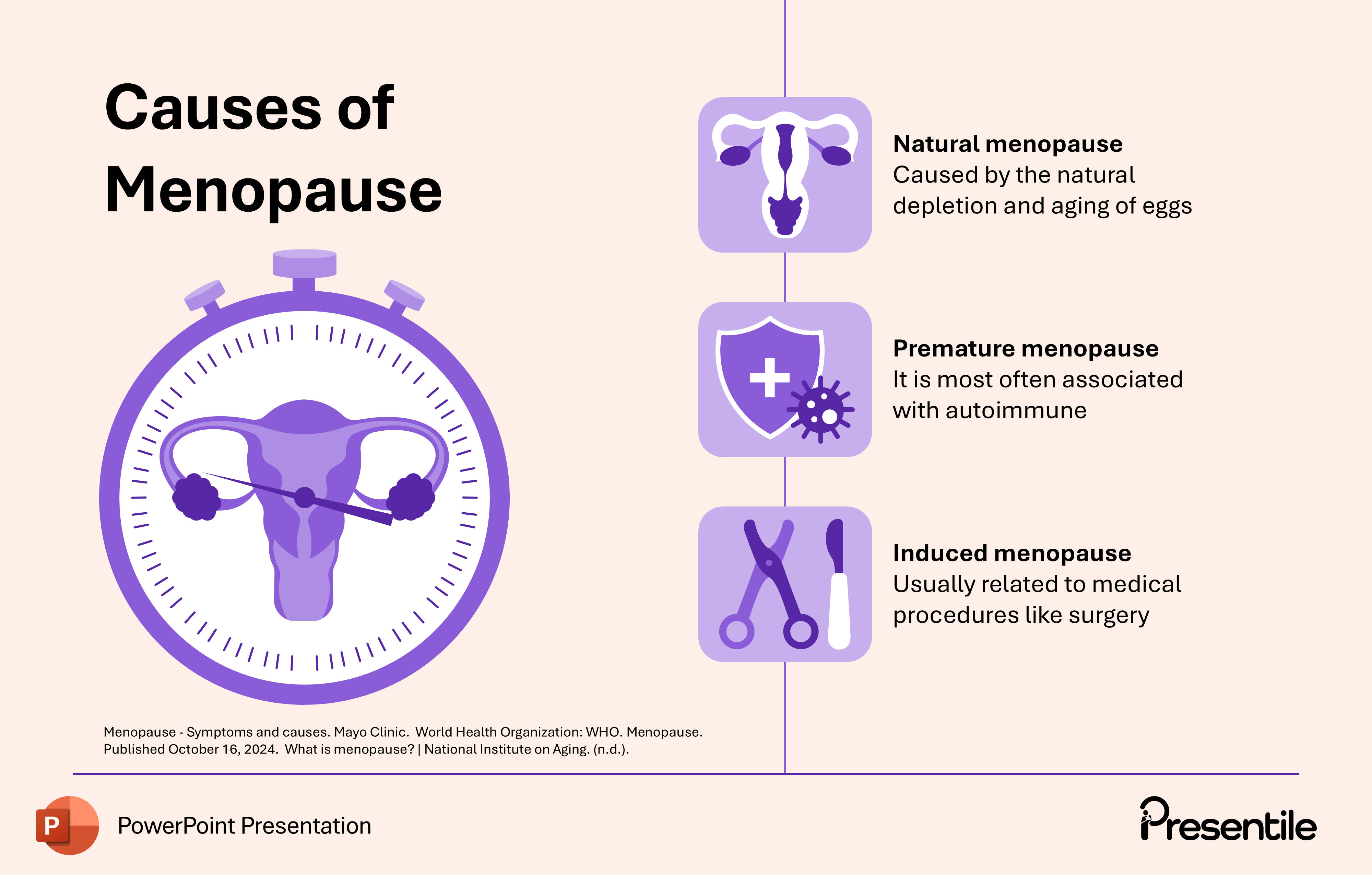
This slide details the three primary categories of why a woman might experience menopause. It uses a central stopwatch icon to emphasize the timing of the event and three distinct panels to categorize the causes.
- Natural menopause: "Caused by the natural depletion and aging of eggs." This is the most common form, an age-related biological process.
- Premature menopause: "It is most often associated with autoimmune" conditions. This highlights the pathological cause when it occurs before the expected age.
- Induced menopause: "Usually related to medical procedures like surgery" (e.g., oophorectomy/hysterectomy). This covers iatrogenic or medically necessitated causes.
Slide 14: Section Focus: Management of Menopause

This slide serves as the transitional header for the final section of the presentation, focusing on the treatment and management of Menopause.
The title "Management of Menopause" is clear and prominent. The visual elements—an illustration of a woman exercising with a dumbbell and a piece of fruit—immediately suggest that the focus of management will be on lifestyle, exercise, and diet, which are key non-pharmacological components of menopausal health.
Slide 15: Management of Menopause – Health Tips (Lifestyle)
.PNG)
This slide details three key non-pharmacological health tips for managing the symptoms and long-term health risks associated with menopause. The overall tone is focused on proactive self-care, reinforced by the visual of a woman exercising.
- Weight management: "Optimal body weight has been associated with symptom reduction," suggesting a link between healthy weight and less severe menopausal symptoms.
- Well-balanced diet: "Assists in the management of multiple menopausal manifestations," emphasizing the role of nutrition in overall health during this phase.
- Regular physical activity: "Reduces multiple symptoms such as hot flashes, improvement of sleep quality," pointing to the direct therapeutic benefits of exercise for common menopausal complaints.
Slide 16: Section Focus: Menopause Management

This slide serves as a final, high-level summary header for the Management section of the Menopause presentation. The title "Menopause Management" is clear. The visual of a woman taking a pill or supplement reinforces the medical and self-care aspect of managing the condition.
Slide 17: Management of Menopause – Medical Therapies

This slide focuses on the medical interventions used to manage menopausal symptoms and complications. It uses three clear icons to categorize the different types of therapy.
- Hormone replacement therapy (HRT): Shown with a pill bottle icon. HRT is a systemic treatment to replace the declining estrogen.
- Topical hormone therapy: Represented by a syringe and female symbol icon. This therapy is typically used for localized symptoms like vaginal dryness.
- Medications for osteoporosis: Illustrated by a pill bottle icon. This addresses the significant long-term risk of bone loss that occurs after estrogen levels drop.
Slide 18: Risks of Menopausal Hormone Therapy (MHT)
.PNG)
This slide provides a critical warning and detail regarding the potential risks associated with Menopausal Hormone Therapy (MHT). It uses a hand holding a pill and three prominent icons to highlight the major risks, which is essential for informed patient education.
- Breast cancer: "Long-term use of MHT is linked to an increased risk of breast cancer."
- Blood clots: "Oral estrogen, is associated with blood clots."
- Stroke: This risk is emphasized, "Especially in individuals with pre-existing cardiovascular risks."
Slide 19: Menopause – Types of MHT (Administration Routes)
.PNG)
This slide details the three primary methods of administering Menopausal Hormone Therapy (MHT), comparing their convenience and risk profiles. This information follows the discussion of MHT risks, providing crucial context for patient choices.
- Tablets (Oral MHT):
- Described as "Easy to take, but may have higher risks of blood clots." This confirms that the oral route is associated with the systemic clot risk mentioned on the previous slide.
- Patches (Transdermal MHT):
- Described as "Absorbed through the skin and are often safer for women." This highlights the reduced risk profile of non-oral administration.
- Vaginal creams (Topical MHT):
- Described as "Often used for vaginal symptoms." This reinforces their use for localized, rather than systemic, relief.
Slide 20: Thank you

This is the final "Thank You" slide, concluding the 20-slide Menopause presentation.
- The text "Thank you" clearly signals the end of the presentation.
- The calendar, clock, and "no drops" female symbol visually summarize the key themes: the timing, the end of the menstrual cycle, and the overall focus on women's health.
Features of
Menopause Presentation
- Fully editable in PowerPoint
- All graphics are in vector format
- Medically Referenced information and data
 Slides count:
Slides count: Compatible with:Microsoft PowerPoint
Compatible with:Microsoft PowerPoint File type:PPTX
File type:PPTX Dimensions:16:9
Dimensions:16:9



